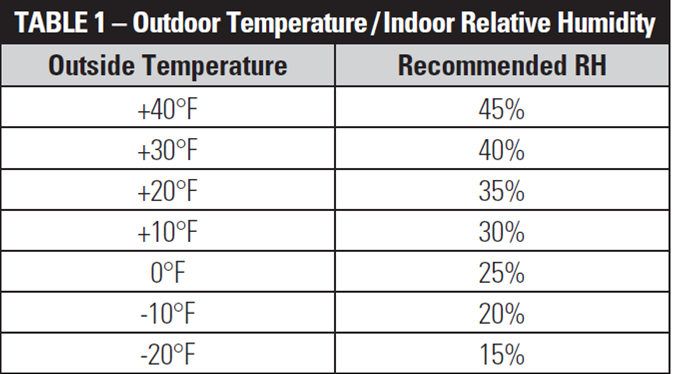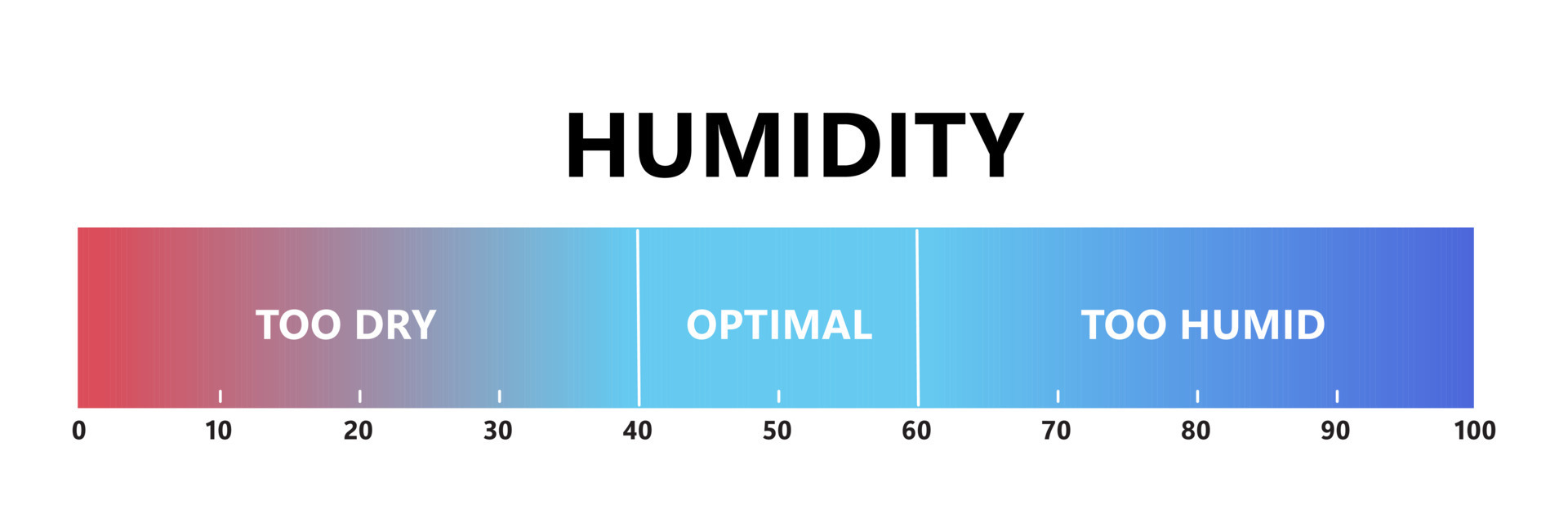What Is The Ideal Humidity For A Bedroom

Are you waking up feeling stuffy, having trouble sleeping, or noticing condensation on your bedroom windows? These could be signs that the humidity level in your bedroom isn't right. Many homeowners struggle with maintaining a comfortable and healthy bedroom environment, often battling issues like excessive dryness in the winter or feeling sticky and uncomfortable during the summer months. Before you jump to expensive solutions, let's walk through a simple, step-by-step troubleshooting process to pinpoint the problem and explore some easy fixes. Remember, your health and comfort are paramount, so knowing when to call in the professionals is key.
Understanding Ideal Bedroom Humidity
First, let's define what "ideal" humidity actually means. Generally, experts recommend maintaining a relative humidity level between 30% and 50% in your bedroom. This range is optimal for comfort, health, and preventing issues like mold growth. Lower than 30% can lead to dry skin, irritated sinuses, and increased susceptibility to colds. Higher than 50% can create a breeding ground for mold, dust mites, and bacteria, exacerbating allergies and respiratory problems.
Step 1: Identifying the Problem – Signs & Symptoms
Before you grab any tools, use your senses! Observe your bedroom for common indicators of humidity imbalance. Here’s what to look for:
Signs of High Humidity:
- Condensation on windows: This is a classic sign that the air is holding too much moisture.
- Musty odors: A damp, musty smell often indicates mold or mildew growth.
- Sticky or clammy feeling: If the air feels heavy and saturated, humidity is likely high.
- Visible mold growth: Look for dark spots on walls, ceilings, or around windows.
- Warped wood: Excess moisture can cause wooden furniture or flooring to warp or buckle.
Signs of Low Humidity:
- Dry skin, chapped lips, or sore throat: These are common physical symptoms of dry air.
- Static electricity: Frequent shocks when touching objects indicate very dry air.
- Cracked or peeling paint: Dry air can cause paint to dry out and crack.
- Splitting wood furniture: Similar to warping, but caused by lack of moisture in the air.
- Increased allergy symptoms: Dry air can irritate nasal passages and exacerbate allergies.
Take a few minutes to carefully assess your bedroom for these signs. Note down everything you observe; this will be helpful in the next steps.
Step 2: Measuring Humidity – Without and With Tools
Subjective observations are a good starting point, but for accurate troubleshooting, you need to measure the humidity level. Here's how you can do it, with and without tools:
Without Tools: The Ice Cube Test
This is a rudimentary test, but it can give you a general idea of humidity levels. Place a glass filled with ice water in your bedroom. Wait about 5 minutes. Observe the glass:
- If condensation forms quickly: The air is likely humid.
- If condensation forms slowly: The humidity is moderate.
- If no condensation forms: The air is likely dry.
Keep in mind this is a very basic indicator and can be affected by room temperature. It's best to move on to a more accurate method.
With Tools: Using a Hygrometer (Humidity Meter)
A hygrometer is a relatively inexpensive and accurate tool specifically designed to measure humidity. You can find them at most hardware stores or online retailers. Here's how to use one:
- Purchase a hygrometer: Choose a digital hygrometer for the most accurate readings.
- Place the hygrometer in your bedroom: Position it away from direct sunlight, vents, or other sources of heat or drafts.
- Wait for the reading to stabilize: It may take 15-30 minutes for the hygrometer to accurately reflect the room's humidity level.
- Record the reading: Note the percentage displayed on the hygrometer.
- Compare to the ideal range: Is the reading within the 30-50% range? If not, proceed to the next steps.
Having a hygrometer is crucial for effectively managing bedroom humidity. It allows you to monitor the impact of any adjustments you make.
Step 3: Diagnosing the Cause – Common Culprits
Now that you know whether your bedroom is too humid or too dry, it's time to investigate the possible causes:
Causes of High Humidity:
- Poor ventilation: Lack of airflow allows moisture to build up. This is especially common in bathrooms or kitchens adjacent to the bedroom.
- Leaky pipes or roofs: Undetected leaks can introduce significant moisture.
- Damp basements or crawl spaces: Moisture can migrate upwards into the bedroom.
- Indoor plants: While plants are beneficial, too many can contribute to humidity.
- Cooking or showering nearby: Steam from these activities can seep into the bedroom.
- Overuse of humidifiers: If you're already using a humidifier, it might be set too high.
- Geographic location: Some climates are naturally more humid than others.
Causes of Low Humidity:
- Heating systems: Furnaces and other heating systems dry out the air.
- Air conditioning: While primarily for cooling, air conditioners also remove moisture.
- Poor insulation: Drafty windows and doors allow dry air to enter.
- Fireplaces: Fireplaces draw air from the room, which can contribute to dryness.
- Geographic location: Desert climates naturally have low humidity.
Carefully consider each of these factors in relation to your bedroom and your living situation. For example, if you live in a humid climate and have poor ventilation, that’s a likely combination causing high humidity. If you live in a cold climate and are constantly running the furnace, low humidity is more probable.
Step 4: DIY Solutions – Simple Fixes You Can Try
Based on your diagnosis, here are some DIY solutions you can try to improve the humidity level in your bedroom:
For High Humidity:
- Improve ventilation:
- Open windows: When the weather permits, open windows to allow fresh air to circulate.
- Use a fan: A fan can help circulate air and reduce stagnant moisture.
- Run the bathroom exhaust fan: After showering, run the exhaust fan for at least 30 minutes to remove moisture.
- Address leaks: Inspect for and repair any leaky pipes or roofs (this may require a professional if the leak is significant).
- Reduce indoor plants: Limit the number of plants in your bedroom.
- Use a dehumidifier: A dehumidifier removes moisture from the air. Choose a size appropriate for your bedroom.
- Without Tools: Check the dehumidifier’s water collection bin regularly and empty it.
- With Basic Equipment: Clean the dehumidifier's filter monthly to ensure efficient operation (requires a screwdriver to access the filter).
- Improve drainage: Ensure that rainwater is properly draining away from your foundation.
- Absorb moisture: Place bowls of baking soda or silica gel packets in areas prone to dampness. These absorb excess moisture from the air. (No tools required)
For Low Humidity:
- Use a humidifier: A humidifier adds moisture to the air. Choose a size appropriate for your bedroom.
- Without Tools: Regularly refill the humidifier with distilled water to prevent mineral buildup.
- With Basic Equipment: Clean the humidifier regularly to prevent mold and bacteria growth (requires a screwdriver to access certain parts). Follow the manufacturer's instructions for cleaning.
- Take shorter, cooler showers: Hot, long showers release a lot of steam, which can contribute to low humidity as the moisture is quickly removed by ventilation systems.
- Dry clothes outdoors: Avoid using the clothes dryer, as it vents warm, moist air outside. Hang clothes to dry indoors to add humidity.
- Boil water on the stove: Simmering a pot of water on the stove allows moisture to evaporate into the air. (Always supervise the stove).
- Seal drafts: Use weather stripping or caulk to seal cracks around windows and doors.
- Without tools: Inspect window and door frames for visible gaps.
- With Basic Equipment: Apply weather stripping or caulk using a utility knife and caulking gun (requires basic hand tools).
Implement these solutions one at a time and monitor the humidity level with your hygrometer. Allow a few days between each adjustment to see its effect.
Step 5: When to Call a Professional – Red Flags and Limits
While many humidity issues can be resolved with DIY solutions, some situations require professional assistance. It’s crucial to prioritize your safety and avoid attempting repairs that are beyond your skill level. Here are some red flags indicating the need for an HVAC technician or other professional:
- Persistent high humidity despite using a dehumidifier: This could indicate a significant leak or underlying structural problem.
- Visible mold growth that covers a large area: Mold remediation is best left to professionals, as improper removal can spread spores and worsen the problem.
- Suspected leaks within walls or ceilings: Locating and repairing hidden leaks requires specialized equipment and expertise.
- Malfunctioning HVAC system: If your heating or cooling system is not functioning properly, it could be contributing to humidity problems. Do not attempt to repair complex HVAC components yourself.
- Electrical issues: Never attempt to repair electrical wiring or components. Contact a qualified electrician.
- You are unsure or uncomfortable with any step of the troubleshooting process: Your safety and well-being are the most important considerations.
Remember, dealing with mold, electrical issues, or complex HVAC repairs can be dangerous and should only be handled by qualified professionals. Don't hesitate to seek help when needed.
Maintaining Ideal Humidity – Long-Term Strategies
Once you've achieved the ideal humidity level in your bedroom, the key is to maintain it. Here are some long-term strategies:
- Regularly monitor humidity levels: Use your hygrometer to track humidity fluctuations and make adjustments as needed.
- Schedule regular HVAC maintenance: Have your heating and cooling system serviced annually to ensure optimal performance.
- Maintain proper ventilation: Ensure that your bedroom has adequate airflow.
- Address leaks promptly: Repair any leaks as soon as they are detected.
- Be mindful of moisture-generating activities: Adjust your habits to minimize excess moisture in the bedroom.
- Consider a whole-house humidifier or dehumidifier: For consistent humidity control throughout your home, a whole-house system may be a worthwhile investment. (Requires professional installation)
By following these steps, you can create a comfortable, healthy, and sleep-conducive bedroom environment. Remember to prioritize your safety and seek professional help when needed. A little proactive troubleshooting and maintenance can go a long way in ensuring your bedroom remains a haven for rest and relaxation. Good luck!










